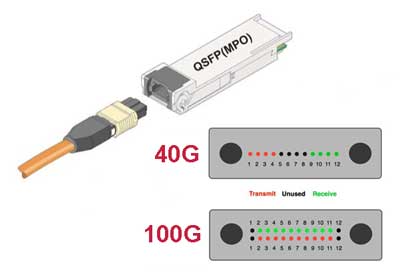As the speed and transfer rates of computer hardware continue to grow alongside demand for ever-more data, new cabling becomes a necessity to keep up. Backbones for 40G on multimode fiber generally use MPO connectors which work with QSFP+ transceivers to allow four simultaneous 10G or better connections. An upgrade to QSFP+ can mean a significant reduction in overall cabling, which brings better reliability and cost-effectiveness.
MPO can work at higher speeds as well, able to bundle hundreds of individual fiber lines at once into a single terminator. As this is a relatively new standard, MPO connectors are not well-understood by many people. However, they're necessary to deliver the speeds promised by today's top-line backbones.
Things You Need To Know About MPO Connectors
1. What Is MPO
MPO is short for the industry acronym—"multi-fiber push on". The MPO connector is a multi-fiber connector which is most commonly defined by two documents: IEC-61754-7 and EIA/TIA-604-5. Here is a MPO connector with parallel optics transceiver and pinouts for 40G and 100G. Generally, the backbone cable that is permanently installed will end in connectors with pins inside mating adapters, effectively creating a "socket" type connection. Patchcords will have no pins since they are subject to damage because they simply protrude from the connector. Transceivers will be set up as jacks also, with pins inside the transceiver socket.

2. MPO vs MTP
One of the biggest areas of confusion is in regards to naming, with the cabling in question sometimes being referred to as MPO or MTP.
MTP is a particular brand of MPO-compliant fiber cables from USConec. They incorporate a number of revisions to the overall design, such as removable connector housings, while still remaining 100% intercompatible with other MPO products.
Whether they're worth the extra money is largely a matter of opinion at this point, although they have their benefits. The key point is that MTP is simply one specific implementation of MPO whose creators, undoubtedly, would like to see become more standard in the future.
Things You Need To Know About 40G QSFP+ Transceivers
QSFP+ transceiver is a hot-swappable, parallel fiber-optical module with four independent optical transmit and receive channels. These channels can terminate in another 40-Gigabit QSFP transceiver, or the channels can be broken out to four separate 10-Gigabit SFP+ transceivers.
The QSFP+ transceiver link length for either 40 Gigabit Ethernet or high density 10 Gigabit Ethernet application is up to 100 m using OM3 fiber or 150 m using OM4 fiber. These modules are designed to operate over multimode fiber systems using a nominal wavelength of 850nm. The electrical interface uses a 38 contact edge type connector. The optical interface uses an 8 or 12 fiber MTP (MPO) connector. For example, both HP JG325B compatible QSFP + transceiver and Arista QSFP-40G-SR4 compatible QSFP + transceiver from Fiberstore can achieve distance of 100m over OM3 fiber and 150 m over OM4 fiber.
Fiberstore offers a wide range of MPO connectors and 40G QSFP+ transceivers which are 100% compatible with many famous brands like Cisco, HP, Juniper, Nortel, Force10, D-link, 3Com. Besides, we also provide high-quality and cost-effective cables such as MTP trunk cables, QSFP+ breakout cable, LC to MTP jumpers, etc.
No comments:
Post a Comment